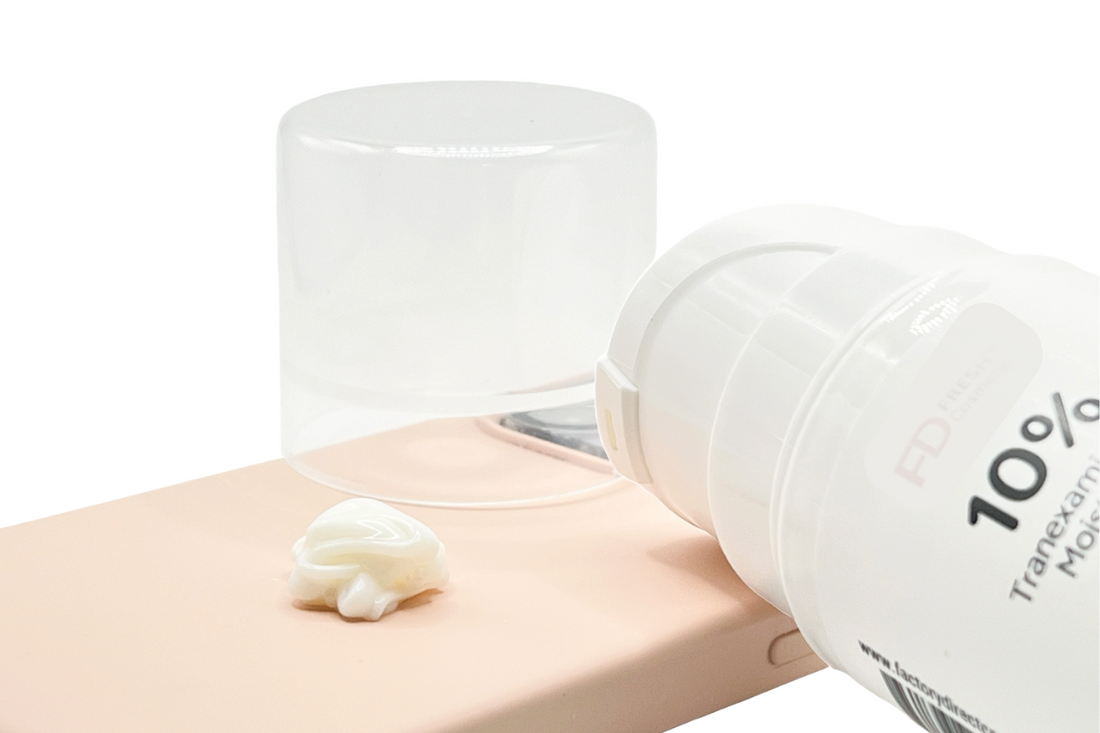
Tranexamic Acid - How to used it in skincare formulations
Share
Tranexamic acid has become popular as a skincare ingredient for hyperpigmentation concerns. But most of us don’t know it is much more than that.
Hyperpigmentation has always been a tough skin concern to deal with. Most skincare ingredients that show sound skin-lightening effects usually have terrible side effects. Hydroquinone is a gold-standard skin-lightening agent used by dermatologists for tough cases. Its cytotoxicity, skin irritation, and permanent skin discoloration are the side effects that are hard to accept by most of us. Studies in recent years have shown that tranexamic acid seems to be an equally effective and much safer alternative.
Tranexamic acid, a derivative of a natural amino acid found in our body, is a unique skincare ingredient that provides not just one but multiple skin benefits when used topically.
Originally, tranexamic acid was a drug used to treat abnormal bleeding. However, a doctor in Japan made a groundbreaking discovery-its skin-lightening properties. This led to clinical studies and the eventual use of tranexamic acid as a safe and effective skin-lightening agent for all types of skin discoloration. In fact, in Japan, oral tranexamic acid is still available as an over-the-counter drug for treating skin discolorations today.
Serval studies have shown that topically applied TXA is also effective against melasma and skin hyperpigmentation caused by sunburn and inflammation, such as sun spots and hyperpigmentation on acne and scars. Because it binds to the lysine site in the melanin synthetic pathway in melanocytes to reduce the melanin, it also lightens the skin tone.

Interestingly, tranexamic acid also works as an antioxidant and anti-inflammatory agent simultaneously without obvious side effects, even when it is used at 10%.
Tranexamic Acid for Skin Concerns?
- Melasma: For fading the dark patches and spots and long-term management of skin pigmentation issues
- Sunspots, age spots, liver spots: they are all basically the same thing caused by accumulative sun damage to the skin
- Post-inflammatory Hyperpigmentation, such as acne and acne scars and hyperpigmentation after skin infections, mosquito bites, and other skin
- Dull and dark skin tone, and darkened skin on elbows and joints.
- Scars after cuts and surgeries
Who shouldn't use tranexamic acid?
As tranexamic acid is a fairly new ingredient used against skin pigmentation, there isn't enough safety data to ensure it is safe for pregnant and becoming pregnant, breastfeeding, and people who have certain health issues. Make sure to consult your healthcare professionals before starting this treatment.
How to formulate with tranexamic acid?
There are a few points to keep in mind when you formulate with tranexamic acid:
- It is water-soluble. The solubility in water is 125mg/ml or 12.5g/100ml
- The most stable pH range is between 5.0-7.0
- Add at cooldown phase, with temperature below 40 °C (104F°)
- Common usage: 3-5% upto 10%
Example of tranexamic acid skincare formula
- 5% Tranexamic acid powder form
- 86% Distilled water -- available in grocery stores
- 0.7% High molecular weight hyaluronic acid
- 1% Euxyl PE 9010
- Glycerin -- optional -- humectant -- available in drug stores
- Propanediol -- optional -- humectant
- Water-soluble bisabolol -- optional for skin-soothing properties
